
The Best Private Luxury Tours of Bhutan
Bhutan, the last magical kingdom on our planet, is nestled in the eastern Himalayas between China and India that presents a fascinating study of a deeply traditional society thriving in the modern world. The "Land of the Thunder Dragon," has a population of Bhutan is just over 800,000, with the majority residing in rural areas and engaging primarily in subsistence farming.
Open Year Around / Recommended Season: Apr – Oct
Our luxury Bhutan tours were expressly created for mature explorers who don’t want to be rushed. Easy Tours is a small boutique agency and we only offer great guides and top upscale lodging. Over 70% of our business today is repeat and referral.
Recommended Bhutan ToursBhutan is a constitutional monarchy with a unique approach to governance, centered on the philosophy of Gross National Happiness (GNH). GNH is a holistic development philosophy that prioritizes the well-being of its citizens over mere economic growth. This philosophy integrates socio-economic development, environmental sustainability, cultural preservation, and good governance.
“ We enjoyed our trip to Bhutan and Nepal immensely! All the places we stayed were fabulous, our guides and drivers were great representatives of their countries and were knowledgeable and friendly, and the scenery and sights were incredible. Everything went like clockwork. Although it was an odyssey to get to Bhutan, the flights were all on time and we never felt hectic. ”
Phyllis Maher
Bhutan’s towns are often set against dramatic landscapes, including steep mountains and deep valleys. The architecture is a highlight, with buildings featuring intricately carved wooden window frames and white-washed walls, adhering to traditional designs. Notable towns include Thimphu, the capital, which combines the old and the new with dzongs (fortresses) and monasteries alongside modern cafes and offices. Paro, with its picturesque landscapes and historic sites, and Punakha, known for its beautiful dzong and temperate climate, are also significant.
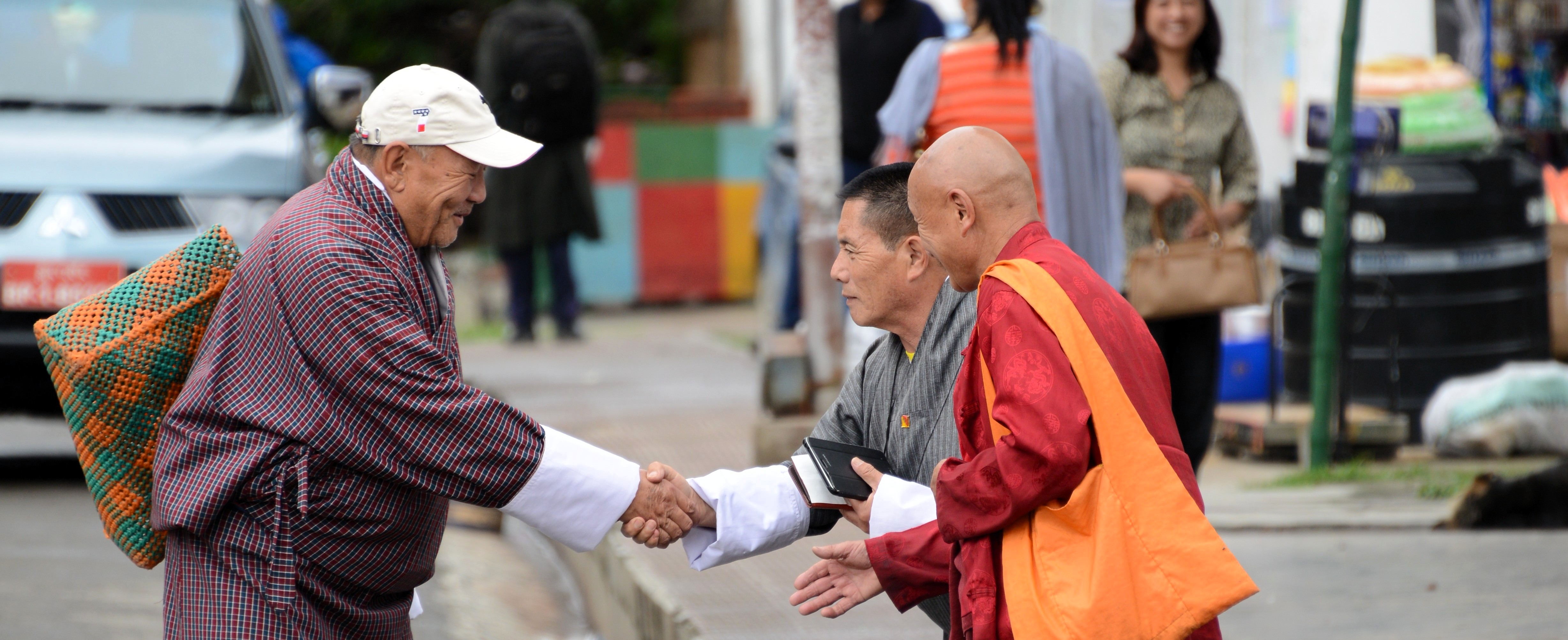
The lifestyle of Bhutanese people is heavily influenced by Buddhist teachings, focusing on happiness and well-being. Agriculture plays a central role in Bhutanese life, with many rural inhabitants engaged in farming. Traditional dress is commonly worn, with men donning the ‘gho,’ a knee-length robe tied at the waist by a belt, and women wearing the ‘kira,’ an ankle-length dress accompanied by a light outer jacket known as a ‘tego.’ Festivals (tshechus) are vital to Bhutanese life, featuring masked dances and music performances that convey Buddhist teachings and the history of Bhutan.
More than 70% of Bhutan’s land is under forest cover, and the lush forests are home to an array of flora and fauna, including several endemic species. Avian life in Bhutan is particularly rich, with over 770 bird species recorded. This includes the rare and majestic black-necked crane and several other endangered species like the white-bellied heron and the imperial heron.
Bhutan's landscape is comprised of mountain terrain interspersed with fertile valleys. The majestic peaks of the Himalayas dominate the northern regions, and are sources of crystal-clear rivers that cascade down to form deep valleys. Bhutan's rivers are not only key to the rural lifestyle and agriculture but also popular for adventure sports like white-water rafting.
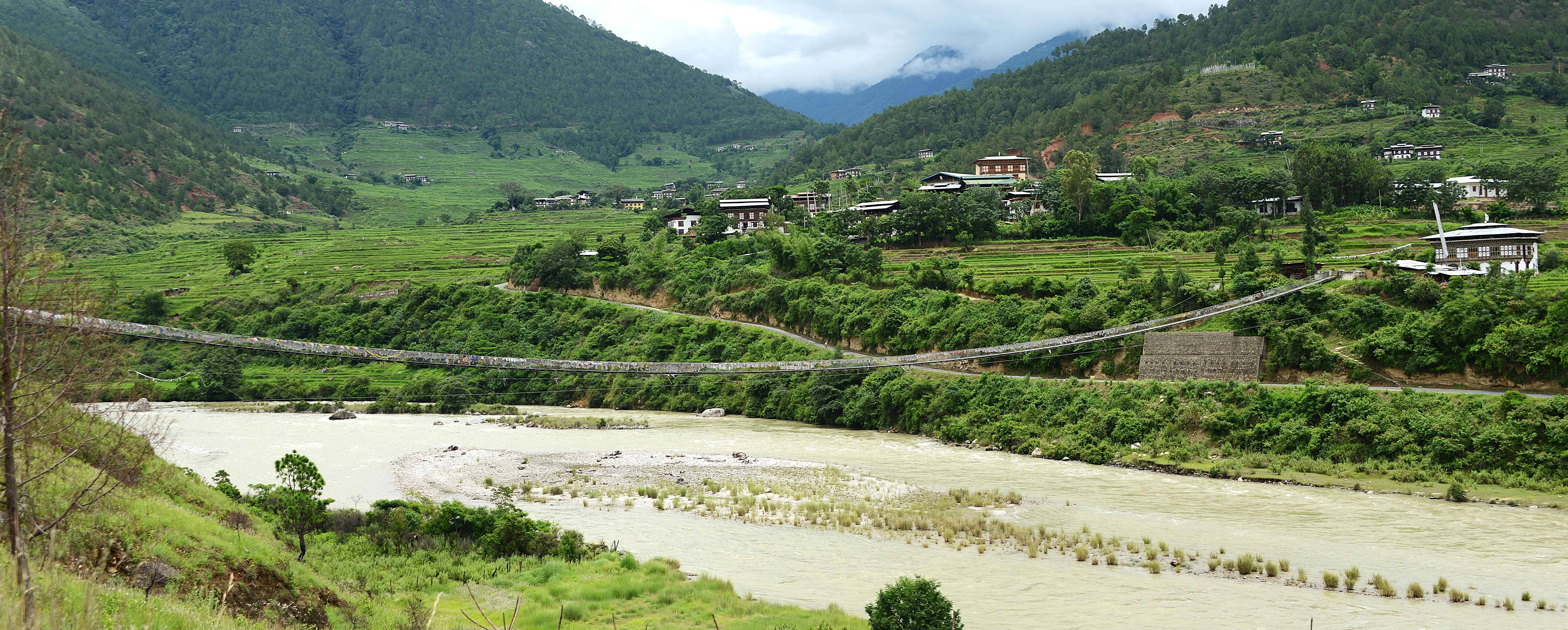
Landscape Punakha
While maintaining strong cultural traditions, Bhutan is also adapting to modernity. Education and healthcare are free, reflecting the country’s commitment to its citizens' welfare. In towns, especially Thimphu, the presence of Internet cafes, mobile phones, and cars illustrates a blend of traditional values with contemporary needs.
Environmentally, Bhutan is notable for its conservation efforts. It is the world's only carbon-negative country, largely due to its vast forested areas, which cover over 70% of its landmass. The government enforces strict environmental policies, ensuring that a significant portion of the country remains under forest cover. Tourism in Bhutan is regulated through a policy of "High Value, Low Impact," and visitors must pay a daily environmental fee.
Destinations in Bhutan
Thimphu, the capital city of Bhutan, is an intriguing blend of traditional Bhutanese culture and the trappings of modernity that make it distinctively unique. As one enters Thimphu, the first thing that strikes is its architecture. The cityscape is dominated by traditional Bhutanese architectural styles, which include dzongs (fortress-like buildings), monasteries, and buildings with intricately painted wooden frames and sloping roofs.
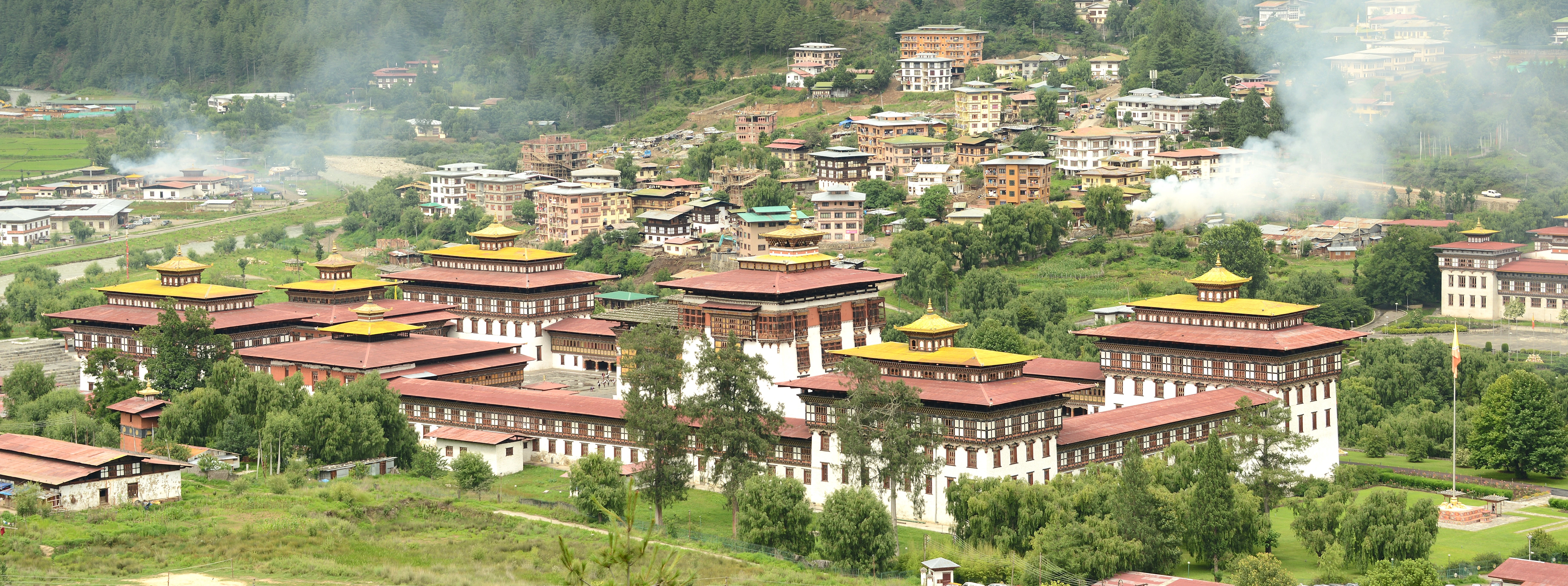
Tashichho Dzong
The heart of Thimphu is the Tashichho Dzong, a stunning Buddhist monastery and fortress which is also the seat of the Bhutanese government. The dzong’s majestic structure and beautiful, meticulously maintained gardens are emblematic of the city’s synthesis of spiritual and secular life. Another significant landmark is the Buddha Dordenma Statue, a gigantic Shakyamuni Buddha statue made of bronze and gilded in gold, which presides over the city from a hilltop, symbolizing the prevalence of Buddhist philosophy in the everyday lives of the Bhutanese people.
In addition to its cultural landmarks, Thimphu is also moving towards modernization with a conscious effort. The city offers contemporary conveniences such as cafes, bars, and restaurants that provide both local and international cuisines. However, unlike many modern cities, Thimphu does not have traffic lights; instead, policemen direct traffic at major intersections, which adds to the city’s quaint charm.
Paro is a captivating valley town is a historical treasure trove, making it a
key destination
for both pilgrims and travelers. The landscape of Paro is dominated by verdant rolling hills and
rugged mountain terrains, interspersed with traditional Bhutanese farmhouses and rice fields, as
the crystal-clear Paro Chhu (river) meanders through the valley. The town itself, though small,
is bustling with activity and offers glimpses into the Bhutanese way of life.
One of the most iconic landmarks in Paro is the Taktsang Monastery, also known as the Tiger’s
Nest. Perched precariously on the side of a cliff, this monastery is a marvel of Bhutanese
architecture and a testament to the religious devotion of the people. Paro is also home to the
Rinpung Dzong, another significant historical structure that serves both as a monastic and
administrative center.
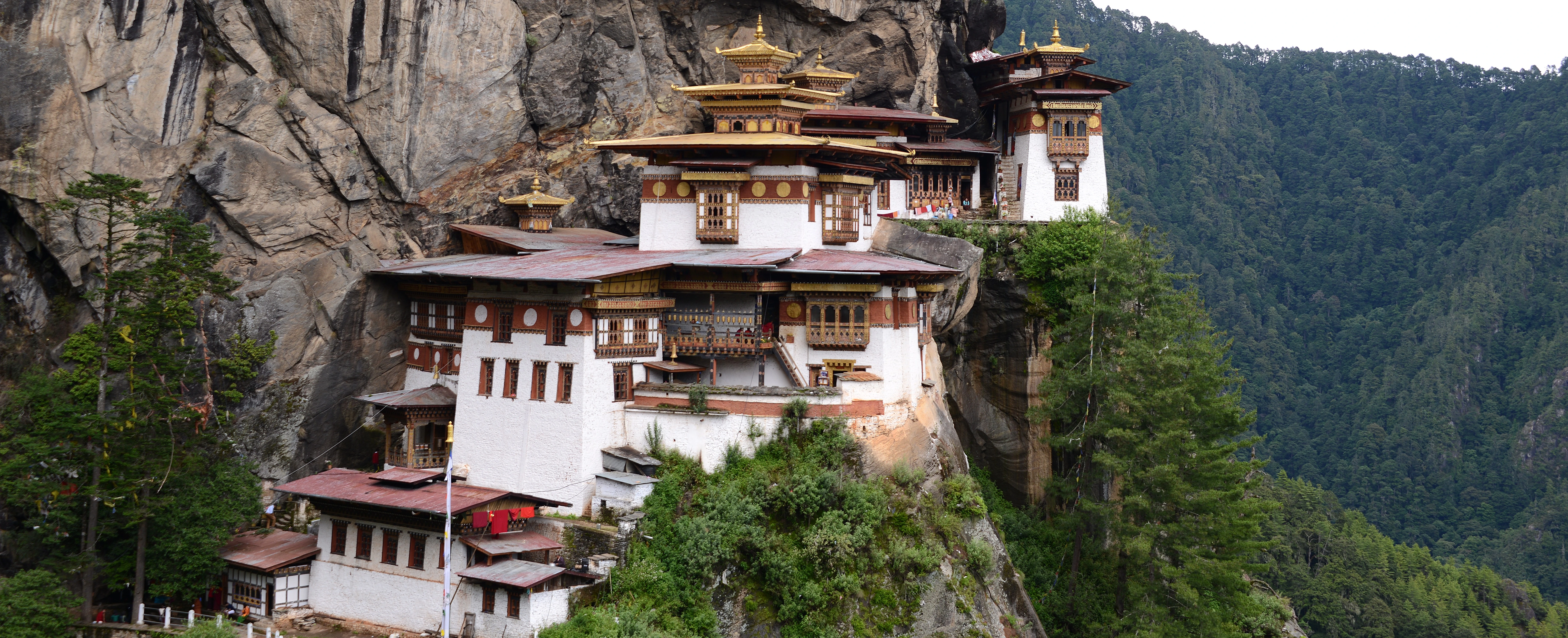
Tigers Nest
Furthermore, Paro serves as an ideal base for various excursions into the surrounding regions,
offering opportunities for trekking, bird watching, and exploring other less-visited monasteries
and temples. The natural landscape, with its pristine forests and wildlife, provides a perfect
setting for nature enthusiasts and adventure seekers.
Punakha is a small quaint town located at 4100 feet above sea level that is cradled by the Pho
Chhu and Mo Chhu rivers, which are known for their significance in Bhutan’s agriculture and
spirituality. The temperate climate makes it an ideal location for rice farming, unlike most
other regions of Bhutan. The town was the capital of Bhutan until 1955 and it offers a landscape
that is both dramatic and enchanting. The surrounding hills are adorned with thick forests of
pine and cedar, while the valley floors are lush with rice paddies and farms. For adventure
seekers and nature lovers, there are numerous trekking trails that wind through the valley
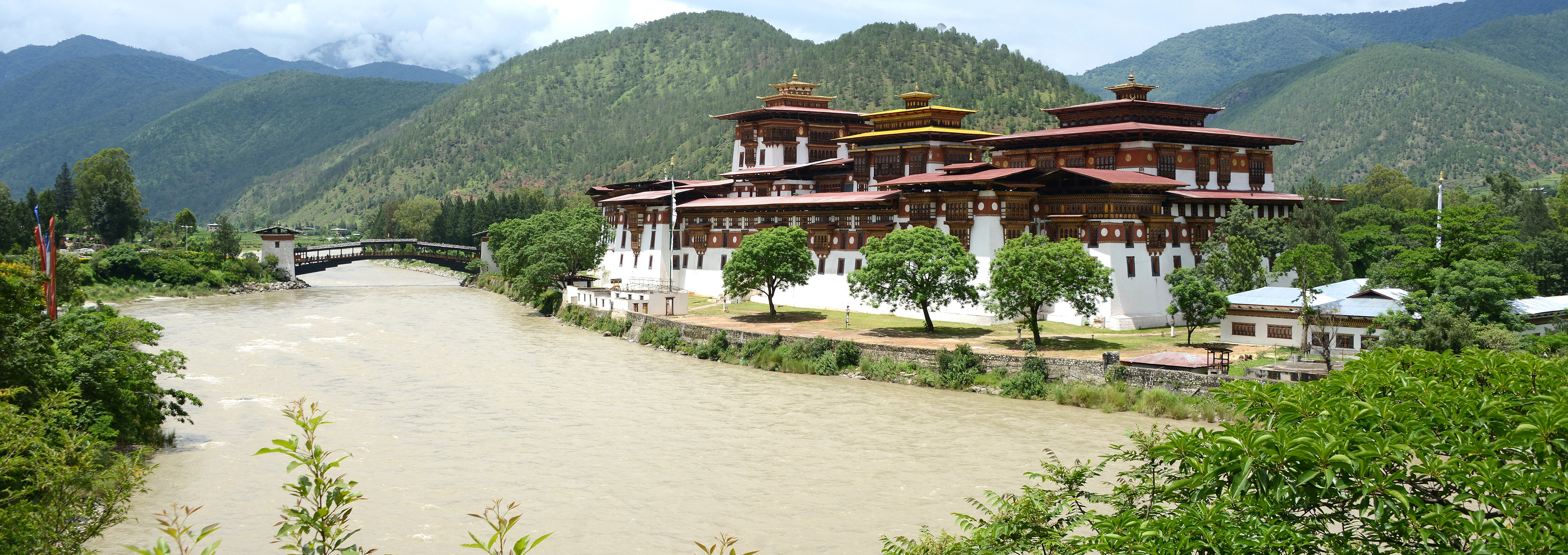
Punakha Dzong
The Punakha Dzong (Palace of Great Happiness), is the most stunning of all Bhutanese Dzong’s due
to its location. Constructed in 1637, it is the second oldest and second-largest dzong in Bhutan
and serves as the winter home of Bhutan’s Central Monastic Body. The dzong is scenically and
strategically located at the confluence of the Pho Chhu and Mo Chhu rivers, making it a majestic
sight. Our guests who visit Punakha will enjoy a picnic lunch with an unmatched view of the
Dzong framed by the rivers and lush mountains.
Gangtey and the Phobjikha Valley are the highest destination we offer in Bhutan
at about 10,000
feet. This glacial valley stands out for its vast expanse of flat valley bottom, and is famous
for its environmental conservation efforts and the black-necked cranes that migrate here from
the Tibetan Plateau during the winter months. These cranes are deeply revered in Bhutanese
culture, believed to be emissaries of peace and longevity.
Gangtey itself is a small village in the Phobjikha Valley, notable primarily for the 17th
Century Gangtey Monastery, which is another stunning example of Bhutanese architecture,
intricate woodwork and beautifully painted frescoes.
The natural scenery of Phobjikha is characterized by its wide and gentle slopes adorned with a
mosaic of potato fields and pastures. These are bordered by dense forests of blue pine,
interspersed with rhododendron trees, adding vibrant splashes of color in the spring. The valley
is part of the Phobjikha Conservation Area, which aims to protect the natural habitat of not
only the black-necked cranes but also other species like the red fox, Himalayan black bear, and
various leopards.
The passion and knowledge of our staff and the extreme attention to detail that we put into
every aspect of your Bhutan tour is what separates us from the rest. We only offer mid-level to
ultra-luxury travel, and so we never compromise on our level of service so as to compete with
budget Bhutan travel agents that focus solely on price. About 70% of our guests are repeat
customers and referrals.
